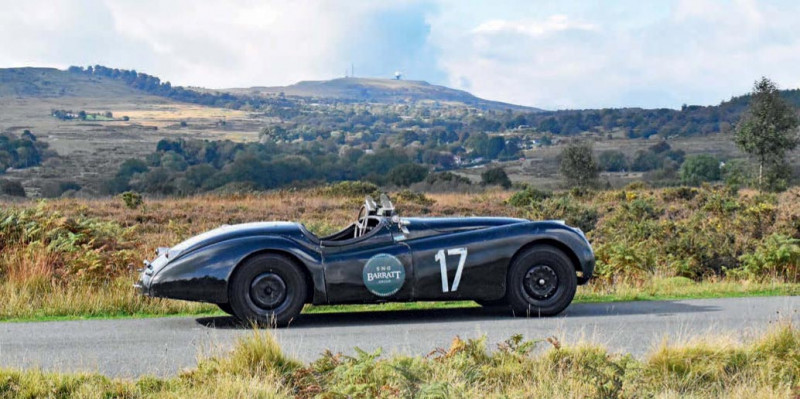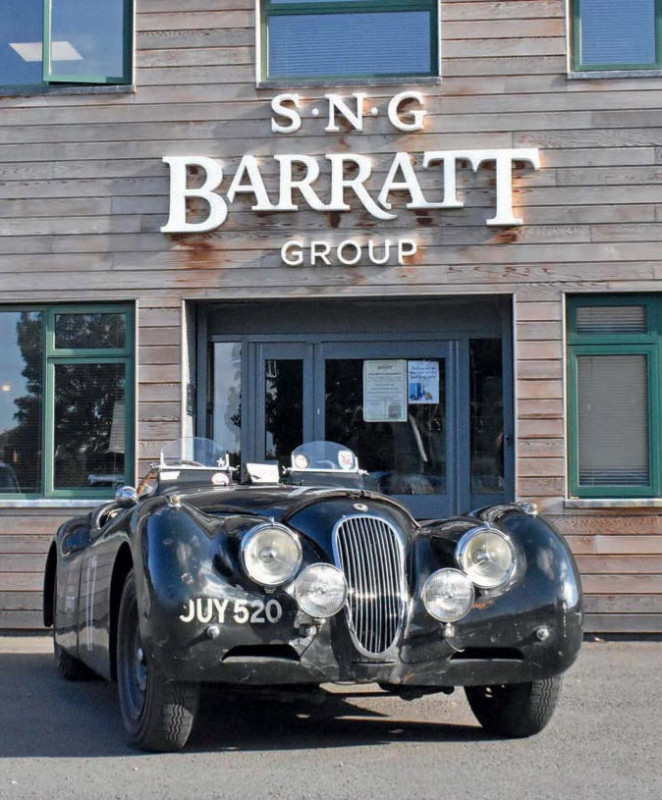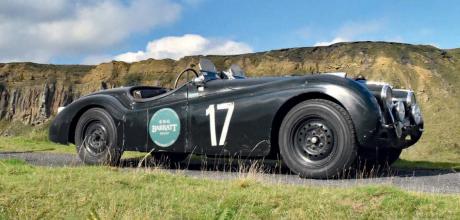Road trip 1950 Jaguar XK120
Peter abandons the concept of luxury and takes to the hills in a rather special XK120…
BLUE REMEMBERED HILLS
Peter Simpson shows us around Shropshire in a very special XK
“...the sight and sound of this historic racing XK120 turned every single head, and each one was smiling.”
Please forgive me if I become a little overexcited as you read the following pages. You would too if you had shared this riproaring experience of piloting a historic XK120 across the dramatic landscape of the Shropshire Hills. The trip came about with astounding good fortune as I received the blessing of SNG Barratt’s CEO, Julian Barratt, to employ the company’s praiseworthy classic Jaguar fleet as photographic subject vehicles for a scenic driving days guidebook that I am compiling. The book’s grand plan includes the intention to match the essential character of a region with that of the Jaguar undertaking the tour, and for the ancient heights of Shropshire I etched a mental image of the barren sweep of the mighty Long Mynd and promptly filled it with the rugged, weather-beaten presence of Barratt’s venerable XK120, itself as equally open to the skies as the windswept moors.

I must also confess to a little trepidation because driving an open XK120 is a raw, muscular adventure, although with the Shropshire Hills being on the doorstep of SNG Barratt’s Bridgnorth headquarters I hoped to conserve sufficient energy to complete the excursion. Driving the car is a full-on undertaking. Apart from there being no roof there is no windscreen, no power steering, no heater, no seatbelts, no mirrors, no indicators, not even door handles. The tiny aero screens are a token effort to wind deflection and the wise would don a flying suit and goggles before embarking on a journey, as the experience is akin to the training of a pre-war fighter pilot. To proceed above 30mph is to invite a constant battle against the elements. Nevertheless, for all the brutality, the involuntary facial grimace frequently converts to a grin because this car is a total hoot to drive.
“...in imagination I became a virtual entrant in a post-war Rallye Des Alpes.”
Let us depart the warmth of SNG Barratt’s welcoming reception area and step inelegantly into the cockpit of the XK. There are no exterior handles to ruin the lines so you must lean over the padded door top and grope within to release the catch. There follows a limbo movement to slide behind the broad radius of the wood rimmed steering wheel. Wood you say? What a concession to luxury!

Flight checks completed and wheel pressing into your chest, turn the ignition on, press the starter button and the engine fires instantly. Throughout the two days I drove the XK it never failed to ignite the first spark. After the push and hope shenanigans of my similarly engine Mk2 I was very impressed by the absence of mischievous intent.
I took the pleasantly winding B4363 to Cleobury Mortimer, an excellent driver’s road of ever-changing gradients, twists and turns. Entering the village just half an hour later to pass beneath the crooked church spire I already felt the effects of a workout. Naturally I expected the effort required to overcome the absence of power steering, although I hadn’t anticipated that the steering would remain equally heavy at all speeds! I am informed that above 100mph the car becomes quite docile, but I chose to defer such antics to men with hair on their chests.
From Cleobury Mortimer I took a loop to explore the narrow moorland roads that crisscross the commons beneath Titterstone Clee Hill. Catherton Common is a particular favourite and was quiet enough to step out and take photographs of the XK set against the scenic backdrops. In all the fun of driving I needed to remember there was a purpose for my being here.
Side roads onto the moorland hills abound and most are worthy, with a particular endorsement being for that leading to the hamlet of Cleeton St. Mary with its idyllic setting. Higher, by Clee Village there are several excellent viewpoints and a highly recommended diversion virtually to the summit of Titterstone Clee Hill. The view is breath-taking in all directions.
A handful of miles to the north and just forty feet taller is Brown Clee Hill, the highest land in the county, but it is the more retiring of the two and often overlooked, with most eyes being drawn to the curious golf ball structures of the former. These domes serve as radar stations, the smaller one recording precipitation data for the Met Office, while the larger monitors aircraft movement within a 100-mile radius. Shropshire is packed with history and unmutilated architecture, never more so than in Ludlow, one of England’s best-preserved towns boasting some 500 listed buildings, an extraordinary tally considering its modest size. From a Norman castle to Tudor timer-framing and elegant Georgian terraces this is a place you simply cannot miss. Not having the ability to lock the doors of the XK it seemed prudent not to abandon the car and take a walk but I urge that you do. The central streets of the town are famously narrow and the sight and sound of this historic racing XK120 turned every single head, and each one was smiling. For indeed this car has considerable pedigree as a racer having been campaigned since new. Strung up in the passenger footwell are original paddock tickets dating back to Goodwood in 1953. I was driving a piece of living history, for this exceptional vehicle is now 72 years old and going as strongly as ever.
From Ludlow I drove north following the A49. There are alternatives but the main road offers equally rewarding views and passes many places of interest, such as the fortified medieval manor house of Stokesay Castle. For much of our tour we are within the boundaries of the Shropshire Hills Area of Outstanding Natural Beauty (AONB). The exceptions are larger areas of population including Bridgnorth, Ludlow and Craven Arms. The most populous settlement in the AONB is Church Stretton, a delightful little market town that grew with Edwardian tourism as a health resort within a landscape described as “Little Switzerland”. For Jaguar devotees it is also known as being the home of the late Norman Dewis, about whom I thought a great deal whilst driving the XK. Even though William Lyons had conceived this car before Norman began work as Jaguar’s Chief Test Engineer, it was as though the XK was crafted with Norman in mind. In particular his diminutively powerful stature. The tales of Norman and XK120s are the stuff of legend, and it was heart-warming to pay my small tribute to the great man as I drove through the town where he spent his retirement years.
The AONB covers around one quarter of Shropshire, which is generally a rural county throughout. Quality of life and community wellbeing is taken very seriously and the AONB is regarded as ‘significantly tranquil’ on a national scale. The authorities actually publish a ‘Tranquillity Map’ of the region to display the quietest areas. However, by anyone’s standards an XK120 is a manifestly non-tranquil presence so, as Church Stretton is considered the least tranquil part of the AONB this is the vicinity in which to let rip if you need to.
The hills rise all around and the finest approach to the heights is via the Burway, a narrow, snaking byway ascending steeply above the Carding Mill Valley. The valley is a celebrated National Trust beauty spot taking its name from a former woollen mill where children toiled to prepare the raw material using ‘cards’, a name for wooden blocks spiked with metal to catch the fibres.
Doubtless the children exercised their lungs climbing the Burway on Sundays, for these were their “Blue Remembered Hills”, as the Poet A.E. Houseman achingly described lost youth in his idealised vision of Shropshire. My own lungs were supplied with abundant fresh air during a spirited ascent of this truly stupendous road, with landscape and XK harmonised as a conduit to a golden age of motoring, where in imagination I became a virtual entrant in a postwar Rallye Des Alpes. Please don’t tell SNG Barratt that I enjoyed the climb so much I turned around and did it again.
The road leads to the open uplands of the Long Mynd, whose name is descriptive for what is an extensive, elevated plateau, dissected by valleys known locally as Batches. For those so inclined the geological significance augments the intoxication of the scenery and the thrill of the drive, because the underlying sandstone rocks hereabouts are amongst the oldest in England. On reaching the summit, the single-track road disappears across a seemingly endless tundra and our route followed it to the furthermost point, passing the home of the Midland Gliding Club who still frequently ‘Bungy Launch’ their aircraft by means of stretchy cables, that literally catapult the glider from the top of the hill. The altitude does the rest. It made my flying machine appear positively tame! Across the valley from the Long Mynd lie the Stiperstones, actually greater in altitude but less extensive. The stones that provide the name are jagged quartzite outcrops spanning a high ridge line and are a wonderful curiosity. The hill is blessed for the traveller by supporting a ribbon of road across a high shoulder, affording unforgettable retrospective vistas of the Long Mynd. There is a parking area for those who wish to stroll to the stones themselves.
This was our furthest point out from Bridgnorth and for the return I chose to recross the Long Mynd, ascending by an alternative but equally scenic route from the hamlet of Ratlinghope, across the aptly named Wild Moor, to meet the outward drive at the top of the Burway. Whilst the ascent of the Burway is the most exhilarating, the descent provides the finest panoramas, above the rooftops of Church Stretton to the volcanic Caer Caradoc Hill. To me that mythical name always sounds like an extract from the Chronicles of Narnia.
I had by this time become familiar with the XK and with the opportunity to open her up a little more on the sinuous B4371 across the wooded Wenlock Edge there came increasing satisfaction with the set-up of the car. Whilst the time-worn patina and battle scars are something that could never be replicated, and scream authenticity, there are a few modifications hidden beyond direct sight. Before SNG Barratt purchased this XK120 the engine had been exchanged for a 3.8-litre unit; a five-speed gearbox was mated to it and the suspension saw modest uprating to handle the frequent track action. In short, other than at times longing to be a muscular pygmy to better grapple with the steering, the XK wasn’t a complete test of virility, and I managed to retain a surprising level of dignity. Back at Bridgnorth I nevertheless arrived with aching arms and windblown hair, like an apparition to frighten the customers into evacuating the building at closing time. But it was with much reluctance that I handed over the keys to terminate my rollercoaster experience, physically tired yet mentally elated and ready, at the first sight of that nice Mr Barratt, to get on my knees and ask if I might perhaps borrow it again.
JUY520’S LIFE WELL LIVED
As we discovered on our flying visit to the Bridgnorth premises of SNG Barratt, JUY520 is but one of SNGB’s fleet of ‘in house’ classic Jaguars. Most famous being 50EE, their Series 1 E-type roadster which must hold some sort of award for the highest number of events and tours attended. We thought it would be interesting to discover the back story to this obviously well-travelled XK120 – SNGBs Peter Stant was only too happy to oblige: “JUY520 first hit the road in November 1950 as a standard 3.4 litre right hand drive open two seater, with shining silver body work and handsome blue interior. Its early life appeared to be fairly unremarkable, passing through several owners until it was spotted on a bomb site car lot by John and Maureen Hicks with a rather shabby two tone red and grey paint finish. Soon returned to a more suitable ‘racing green’, JUY was enthusiastically campaigned by Maureen at several sprints and hills climbs picking up many trophies along the way — including a class win at Santa Pod drag strip! Now with a competition pedigree, subsequent owners added their own modifications and performance parts. More recently these have included a 3.8 litre engine, electronic ignition, high output alternator, a competition ‘Facet’ fuel pump feeding twin 2” SU carburettors, five speed gearbox and a high flow radiator with an additional electric fan. A side exit straight through exhaust system has given JUY quite a distinctive voice. The screen and fabric hood are long gone, replaced by aero screens and a low level rear view mirror. The brakes and suspension have been given similar treatment – JUY now has four wheel disc brakes, modern adjustable dampers and anti-tramp bars at the rear. All suspension bushes have been replaced with polyurethane and front ball joints are now ‘sealed for life’ units. The original wire wheels have been replaced by drilled and lightened steel wheels. These reduce unsprung weight and aid cooling, whilst giving the car quite a distinctive period look.
Although a great deal of time and effort has gone into making JUY into the wild ride that it is today, the external bodywork remains entirely unrestored and still sports the same racing green it was given in the mid-sixties. Every panel exhibits knocks, scrapes and patches of corrosion which tell a convincing story of a car which has worked hard for a living. Over the last fifty years, the paintwork has developed a gorgeous patina which could never be recreated. The one visible nod to creature comfort is the recent addition of a pair of period bucket seats, the originals had sagged and the leather had become too brittle to revive and the internal stuffing was exuding from the seams like an overly loved teddy bear. The new seats hold the driver firmly in position whilst still retaining the look of a classic racer.” So now we know!
What an Open Two-Seater was made for; glorious driving on the lofty Stiperstones. The National Trust own and preserve much of these ancient landscapes. A.E. Houseman’s Blue Remembered Hills in autumnal hue. The XK120 turned all heads without exception The domes monitor aircraft within one hundred miles, but the odd flying machine sneaks under the radar The XK120 is unleashed on the Burway.
Priceless patina and paddock tickets through the ages Historic Ludlow.
SNG Barratt Headquarters, Bridgnorth
Catherton Common, beneath the Clee Hills
“...the sight and sound of this historic racing XK120 turned every single head, and each one was smiling.”


